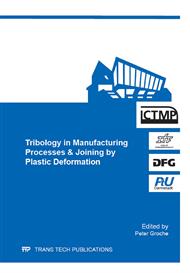[1]
Vollertsen, F., Biermann, D., Hansen, H.N., Jawahir, I.S., Kuzman, K. (2009) Size effects in manufacturing of metallic components, CIRP Annals - Manufacturing Technology, Vol. 58/2, pp.566-587.
DOI: 10.1016/j.cirp.2009.09.002
Google Scholar
[2]
Sam, R., Yu, B., Chen, M., Eagleson, M. (2001) Advances in Laser Microwelding. In Proc. 20th International Congress on Applications of Lasers & Electro-Optics (ICALEO 2001). Chen, X. (Ed. ), 15. 10. - 18. 10. 2001, Jacksonville, FL, USA, F402.
DOI: 10.2351/1.5059785
Google Scholar
[3]
Kamada, K., Nakamura, Y., Ohmori, A., Matsunawa, A., Katayama, S., Arata, Y. (1987).
Google Scholar
[4]
Smolka, G., Gillner, A., Bosse, L., Lützeler, R. (2004) Micro Electron Beam Welding and Laser Machining - Potentials of Beam Welding Methods in the Micro-System Technology. Microsystem Technologies 10, pp.187-192.
DOI: 10.1007/s00542-003-0347-2
Google Scholar
[5]
Neugebauer, R., Bouzakis, K. -D., Denkena, B., Klocke, F., Sterzing, A., Tekkaya, A.E., Wertheim, R. (2011) Velocity effects in metal forming and machining processes, CIRP Annals- Manufacturing Technology, Volume 60, Issue 2, pp.627-650.
DOI: 10.1016/j.cirp.2011.05.001
Google Scholar
[6]
Zhang, Y., Babu, S., Daehn, G.S. (2010) Impact Welding in a Variety of Geometric Configurations. 4th International Conference on High Speed Forming, pp.97-107.
Google Scholar
[7]
Patent (USA) (2011) Low-Temperature Spot Impact Welding Driven Without Contact, Pub. Nr. US 2011/0000953 A1.
Google Scholar
[8]
Barchukov, A. I., Bunkin, F. V., Konov, V. I., Lyubin, A. A. (1974) Investigation of low-threshold gas breakdown near solid targets by CO2 laser radiation, Sov. Phys. -JETP, 39-3, pp.469-477.
Google Scholar
[9]
O'Keefe, J.D., Skeen, C.H., York, C.M. (1973) Laser-induced deformation modes in thin metal targets, J. of App. Phys., 44-10, pp.4622-4626.
DOI: 10.1063/1.1662012
Google Scholar
[10]
Walter, D., Michalowski, A., Gauch, R., Dausinger, F. (2007).
Google Scholar
[11]
Vollertsen, F., Schulze Niehoff, H., Wielage, H. (2009) On the acting pressure in laser deep drawing, Production Engineering - Research and Development, 3/1, pp.1-8.
DOI: 10.1007/s11740-008-0135-z
Google Scholar
[12]
Wielage, H. (2011) Hochgeschwindigkeitsumformen durch laserinduzierter Schockwellen, Dissertation, BIAS-Verlag, Bremen.
Google Scholar
[13]
Wielage, H., Schulze Niehoff, H., Vollertsen, F. (2008).
Google Scholar
[14]
Vollertsen, F., Blaurock, L., 2009. Einfluss der Umformgeschwindigkeit und der Messauflösung auf das Formänderungsverhalten in der Mikroblechumformung, 4. Kolloquium Mikroproduktion, Eds.: F. Vollertsen, S. Büttgenbach, O. Kraft, W. Michaeli, BIAS-Verlag Bremen, Bremen, pp.243-252.
Google Scholar
[15]
Wielage, H., Vollertsen, F. (2011) Undercuts by Laser Shock Forming, The 14th International ESAFORM Conference on Material Forming, AIP Conf. Proc. 1353, American Institute of Physics, ISBN: 978-0-7354-0911-8, pp.1309-1312.
DOI: 10.1063/1.3589697
Google Scholar
[16]
Hintz, G. (1997) Untersuchung der Druckerzeugung und der Strahl-Stoff-Wechselwirkung an einem Excimerlaser-System für die Schockbehandlung von Metallen, Dissertation, Universität Erlangen-Nürnberg.
Google Scholar
[17]
Eisner, K. (1998) Prozeßtechnologische Grundlagen zur Schockverfestigung von metallischen Werkstoffen mit einem kommerziellen Excimerlaser, Dissertation, Universität Erlangen-Nürnberg.
Google Scholar
[18]
Wielage, H., Vollertsen, F. (2012).
Google Scholar
[19]
Vollertsen, F. (2013) Micro Metal Forming, Springer, Heidelberg, Germany, p.86.
Google Scholar


